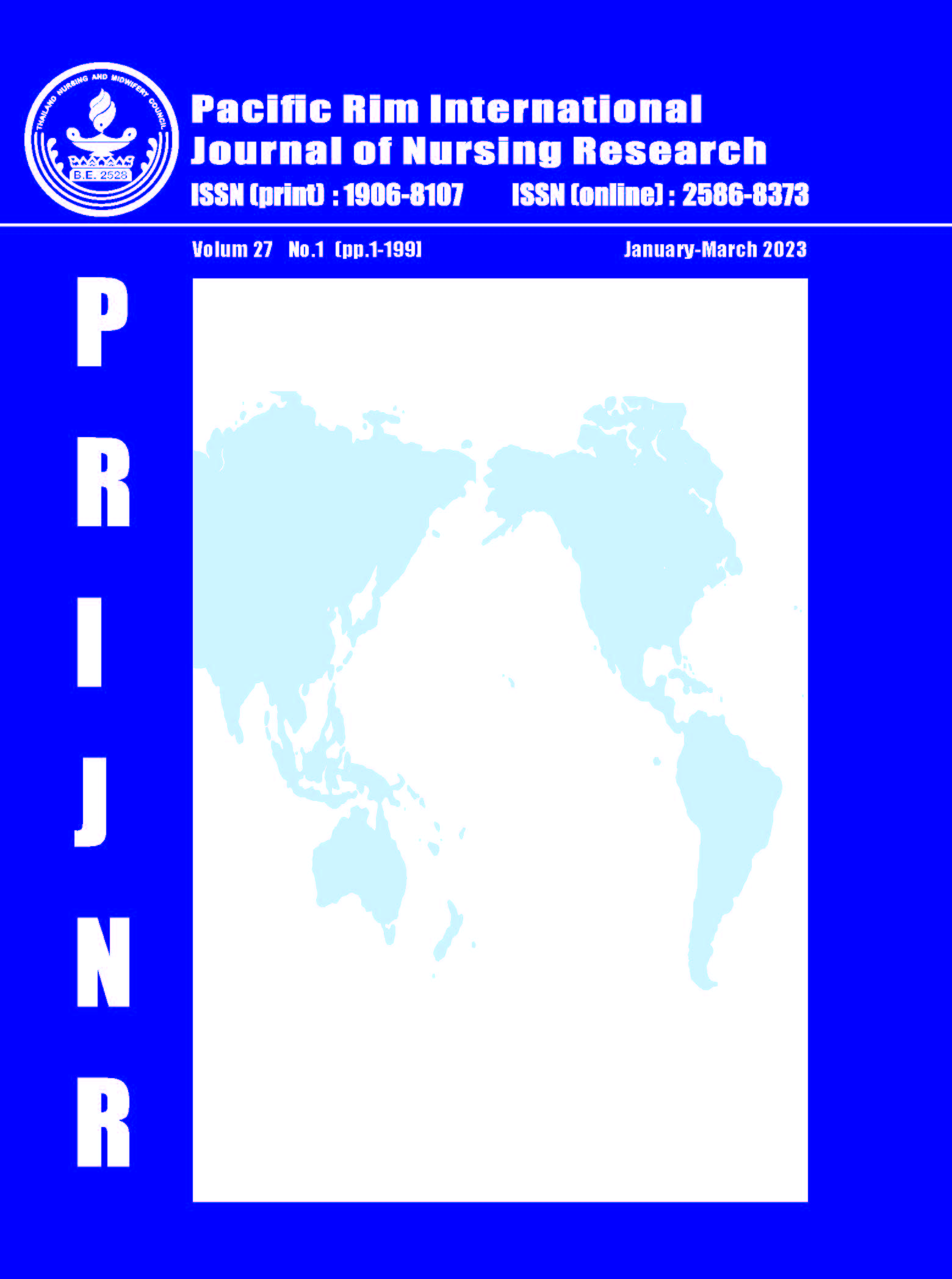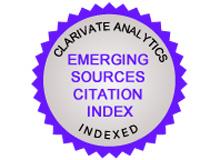Development and Feasibility of the Emergency Medical Services Hub for Northern Thai Older Adults: An Action Research Study
DOI:
https://doi.org/10.60099/prijnr.2023.260335Abstract
Most older adults have unique needs and are suffering from chronic diseases. It is important to have quick and easy access to emergency medical services. Three-phase action research aimed to develop and assess the feasibility of implementing the Emergency Medical Service Hub for Older Adults Model in Upper Northern Thailand was conducted. In phase I and phase II, 27 emergency healthcare providers and 10 older adults were purposively recruited, and in phase III 16 emergency healthcare providers evaluated the feasibility of the model. The framework guided the study was based on action research methodologyand six emergency medical services system functions. Data were collected via in-depth interviews, observation, and self-report of the implementation feasibility questionnaire. All research instruments were validated by three experts, yielded a content validity index of 0.80-1, and the reliability test of the implementation feasibility questionnaire revealed a Cronbach’s alpha coefficient of 0.81. Data were analyzed using descriptive statistics and content analysis.
The final model consisted of six components: effective communication, registry and database, geographic information system, effective emergency medical service team, one-stop service emergency department for older adults, and continuum of care. Overall, the possibility of the model implementation was rated as high. The benefit and safety aspect of implementing the model was at the highest level, followed by its applicability. The use of the model is likely to benefit older adults. Effective implementation requires proper resource support and future study to examine the effectiveness of the model in a full-scale clinical trial is recommended.
References
Sangsaraphun V. Aging society & Thai society’s challenges [Internet]. 2018 [cited 2022 July 15]. Available from: http://www.fpo.go.th/eresearch/getattachment/bd807923-e845-4875-a9b1-ef946538784c/9178.aspx
Buaubol K. What will change…when Thailand becomes a longevity society. TDRI. 2019;34(4):4-9 (in Thai).
Lumjeaksuwan M, Patcharasopit S, Seksanpanit C, Sritharo N, Aeampuck A, Wittayachamnankul B. Trend of emergency department visits among the elderly in Thailand. WHO South-East Asia J Public Health. 2022;10(1):25-8.
Kumsuchat S. Health problems and health care needs among Thai elderly: policy recommendations. J Med Health Sci. 017;26:1156-64 (in Thai).
Duong HV, Herrera LN, Moore JX, Donnelly J, Jacobson KE, Carlson JN, et al. National characteristics of emergency medical services responses for older adults in the United States. Prehosp Emerg Care. 2018;22:7-14. doi: 10.1080/10903127.2017.1347223.
Brunetti ND, Gennaro LD, Dellegrottglie G, Amoruso D, Antonelli G, Biase MD. A regional prehospital electrocardiogram network with a single telecardiology “hub” for public emergency medical service: technical requirements, logistics, manpower, and preliminary results. Telemed J E Health. 2011;17(9):727-33. doi: 10.1089/tmj. 2011.0053.
Bureau of highway safety department of highways ministry of transport. Traffic accident on National highways in 2020 [Internet]. 2020 [cited 2022 July 15]. Available from: http://bhs.doh.go.th/files/accident/63/report_accident_ 2563.pdf
Schooley S, Horan TA. Emergency digital technologies in emergency medical services: considerations and strategies to strengthen the continuum of care [Internet]. 2015 [cited 2022 July 15]. Available from: https://www.ems.gov/pdf/advancing-ems-systems/Reports-and-Resources/Emerging_Digital_Tech_In_EMS.pdf
National Institute for Emergency Medicine. National Institute for Emergency Medicine twenty-year strategic plan (2018-2037)[Internet]. 2020 [cited 2022 July 15]. Available from: https://www.niems.go.th/1/Ebook/Detail/1170?group=36
Tanuchit S, Chinnacom D, Malathong N, Doungthipsirikul S, Tantivass S. Recommendations for emergency medical service for the elderly in Thailand. JPR2R, 2019;57-68.
Lee SB, Oh JH, Park JH, Choi SP, Wee JH. Difference in youngest-old, middle-old, and oldest-old patients who visit the emergency department. Cli Exp Emerg Med. 2018;5(4), 249-55.
Hjalmarsson A, Holmberg M, Asp M, Ostlund G, Nilsson KW, Kerstis B. Characteristic patterns of emergency ambulance assignments for older adults compared with adults requiring emergency care at home in Sweden: a total population study. BMC Emerg Med, 2020;20:1-12.
Forsgarde ES, Elmqvist, C, Fridlund B, Svensson A, Andersson R, Roost M. Patients’ age ≥ 65 years dispositions during ambulance assignments, including factors associated with non-conveyance to hospital: a longitudinal and comparative study. BMJ. 2020;1-7. doi: 10.1136/bmjopen-2020-038885.
Silawan T, Khansakorn N, Laothong U. Factors influencing perceived needs for emergency medical services among elderly patients from four provinces in Thailand. Southeast Asian J Trop Med Public Health. 2019;50(5):925-34.
Choutko-Joaquim S, Tacchini-Jacquier N, D’Alessio GP, Verloo H. Associations between frailty and delirium among older patients admitted to an emergency department. Dement Geriatr Cogn Disord Extra. 2019;9(2):236-49.
Regen E, Phelps K, van Oppen JD, Riley P, Lalseta J, Martin G, et al. Emergency care for older people living with frailty: patient and carer perspectives. Emerg Med J. 2022;39:726-32. doi: 10.1136/emered-2022- 212420.
Khansakorn N, Silawan T, Rawiworrakul T, Kittiphichai V, Laothong U. The study on emergency medical service for the elderly. research report [Internet]. 2016 [cited 2022 July 15]. Available from: https://www.niems.go.th/1/upload/migrate/file/255911291527463047_276dqvbz2kfisI9b.pdf
Kemmis S, McTaggart R, Nixon R. The action research planner: doing critical participatory action research [Internet]. 2014 [cited 2022 Oct 1]. Available from: https://link.springer.com/book/10.1007/978-981-4560-67-2
Shatpattnanunt B, Wiangosot S, Pintatham K. Elderly patients’ experience in using emergency medical service at a tertiary hospital, Upper Northern Thailand. Songklanagarind J Nurs. 2018;38(3):102-15 (in Thai).
Tong A, Sainsbury P, Craig J. Consolidated criteria for reporting qualitative research (COREQ): a 32-item checklist for interviews and focus groups. Int J Qual Health Care. 2007;9(6):349-57.
World Medical Association. World medical association declaration of Helsinki: ethical principles for medical research involving human subjects [Internet]. 2000 [cited 2022 July 15]. Available from: https://www.who.int/bulletin/archives/79(4)373.pdf
Holloway I, Wheeler S, Qualitative research in nursing and healthcare 3rd ed. Oxford: Blackwell; 2010.
Ministry of Social Development and Human Security. The Older Persons Act B.E. 2546. Bangkok: National Office of Buddhism Publisher [Internet]. 2007. [cited 2022 July 15]. Available from: http://thailaws.com/law/t_laws/tlaw0405.pdf
Ponsen K. Sirisamutr T. Wachiradilok P. The situation of using emergency medical services at the emergency department of emergency patients in Thailand. J Health Ed. 2018;41(2):51-63 (in Thai).
Cauwer HD, Barten D, Willems M, Mieren GV, Somville F. Communication failure in the prehospital response to major terrorist attacks: lessons learned and future directions. Eur J Trauma [Internet]. 2022. [cited 2022 Oct 13]Available from: https://doi.org/10.1007/s00068-022-02131-6
Geboers B, Uiters E, Reijneveld SA, Jansen CJM, Almansa J, Nooyens ACJ, et al. Health literacy among older adults is associated with their 10-years’ cognitive functioning and decline – the Doetinchem cohort study. BMC Geriatrics. 2018;18:1-7.
Mwakilasa MT, Foley C, O’Carroll T, Flynn R, Rohde D. Care experiences of older people in the emergency department: a concurrent mixed-methods study. J Patient Exp. 2021; 8:1-8. doi: 10.1177/23743735211065267.
Rhew DC, Letvak S, McCoy TP. The effects of an educational intervention on emergency nurses’ attitude, knowledge, and care behaviors toward older adults. BJSTR. 2017;1(7):1-7.
Holmstrom IK, Kaminsky E, Lindberg Y, Spangler D, Winblad U. The perspectives of Swedish registered nurse about managing difficult calls to emergency medical dispatch centres: a qualitative descriptive study. BMC Nursing. 2021;(20):1-8. doi: 10.1186/s12912-021-00657-5.
Ramsell E, Pilemalm S, Granberg TA. Using volunteers for emergency response in rural areas – Network collaboration factors and IT support in the case of enhanced neighbors [Internet]. 2017 [cited 2022 July 16]. Available from: https://www.diva-portal.org/smash/get/diva2:11 48869/FULLTEXT01.pdf
Jiaviriyaboonya P. Anthropological study of village health volunteers’ (VHVs’) socio-political network in minimizing risk and managing the crisis during COVID-19. Heliyon. 2022;8:1-8.
Khaled ZEL, Mcheick H. Case studies of communications systems during harsh environments: a review of approaches, weaknesses, and limitations to improve quality of service. IJDSN. 2019;15(2):1-22. doi: 10.1177/1550147719829960.
Hoover, R. Benefits of using an electronic health record. Nurs Crit Care. 2017;12(1):9-10. doi: 10.1097/01.CCN.0000508631.93151.8d.
Meisel ZF, Shea JA, Peacock NJ, Dickinson ET, Paciotti B, Bhatia R, et al. Optimizing the patient handoff between emergency medical services and the emergency department. Ann Emerg Med. 2015;65(3):310-7. doi: 10.1016/j.annemergmed.2014.07.003.
Scerpella DL, Adam A, Marx K, Gitlin LN. Implications of geographic information system (GIS) for targeted recruitment of older adults with dementia and their caregiver in the community: a retrospective analysis. Contemp Clin Trials Commun. 2019;14:1-6. doi: 10.1016/j.conctc.2019.100338.
Sritart H, Tuntiwong K, Miyazaki H, Taertulakarn S. Disparities in healthcare services and spatial assessments of mobile health clinics in the border regions of Thailand. Int J Environ Res Public Health. 2021;18:1-24.
Hedges AR, Johnson HJ, Kobulinsky LR, Estock JI, Eibling D, Seybert AI. Effects of cross-training on medical teams’ teamwork and collaboration: use of simulation. Pharmacy. 2019;7(13):1-10. doi: 10.3390/pharmacy7010013.
Xia Y, Cao-Yun Z, Chen Y. Practice and effect of one-stop service of dental clinic for old people. Shanghai Journal of Stomatology. 2018;27(3):433-5. (in Chinese).
Keene SE, Cameron-Comasco L. Implementation of a geriatric emergency medical assessment team decreases hospital length of stay. Am J Emerg Med. 2022;55:45-50.
Duong H, Herrera LN, Moore JX, Donnelly J, Jacobson KE, Carlson JN, et al. National characteristics of emergency medical service response for older adults in the United States. Prehosp Emerg Care. 2018;22(1):7-14.
Downloads
Published
How to Cite
Issue
Section
License
Copyright (c) 2022 Pacific Rim International Journal of Nursing Research

This work is licensed under a Creative Commons Attribution-NonCommercial-NoDerivatives 4.0 International License.
Copyright: The Pacific Rim International Journal of Nursing Research, Thailand Nursing & Midwifery Council has exclusive rights to publish, reproduce and distribute the manuscript and all contents therein.








.png)



